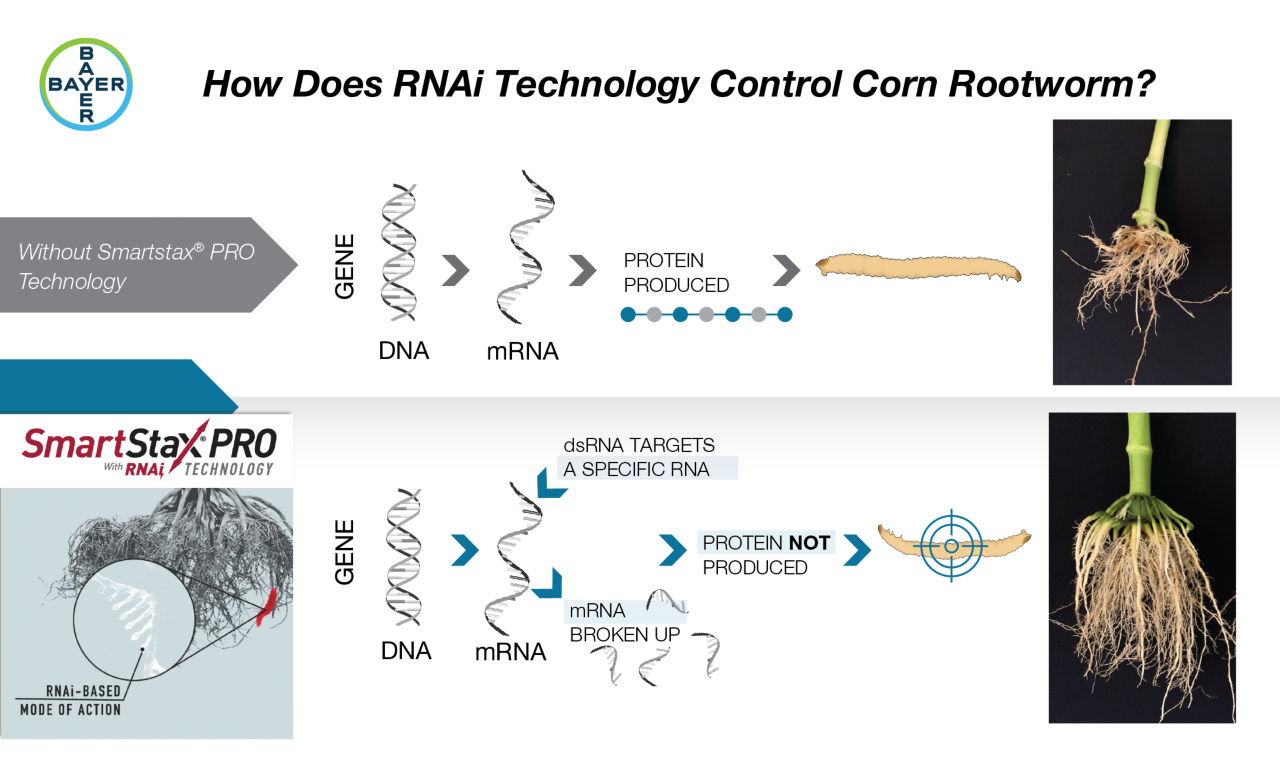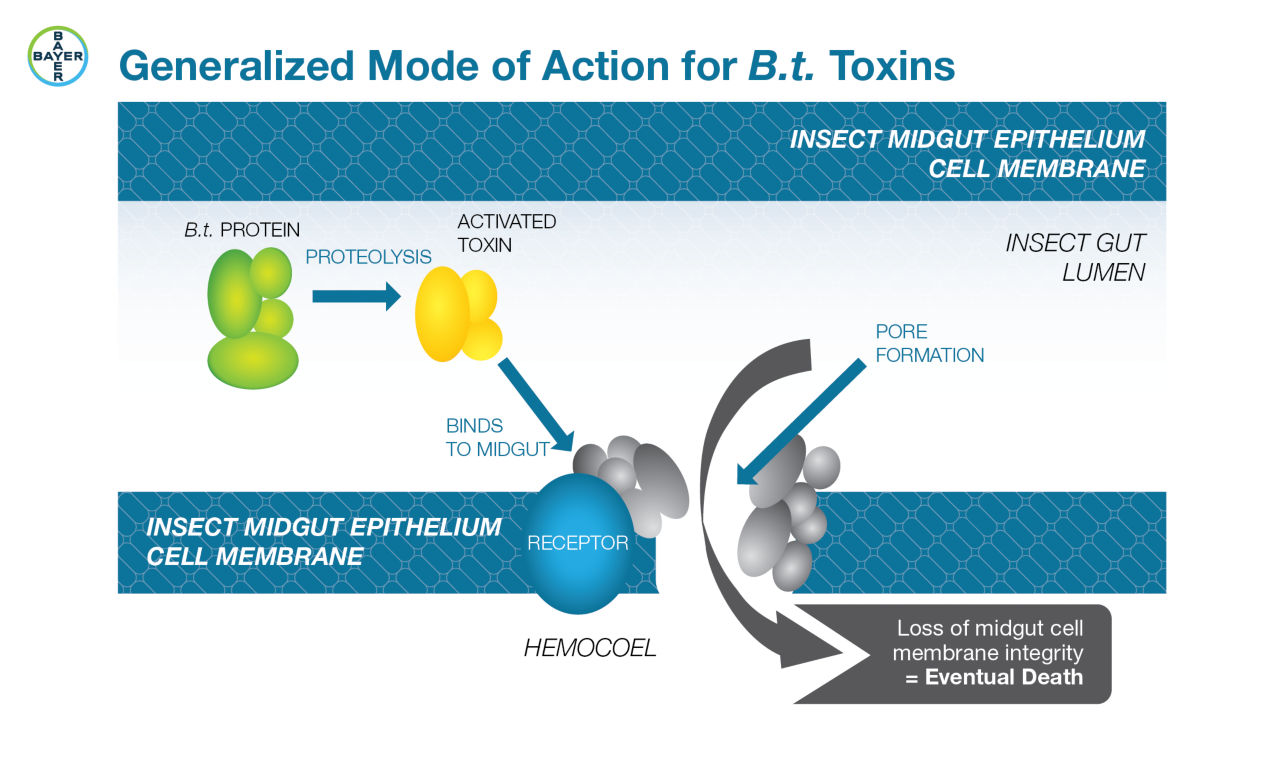How does RNAi Work in SmartStax Pro
September 29, 2022
The Science Behind RNAi Technology and SmartStax® PRO Technology
The understanding of RNAi (ribonucleic acid interference) technology begins with an understanding of DNA (deoxyribonucleic acid) and RNA (ribonucleic acid). Living organisms are comprised of genes which are made from long molecules (DNA) that provide the information needed to create the proteins that are necessary for life. Each DNA molecule has two molecular strands (double stranded or double helix) that are connected to each other like ladder rungs. Each piece of the genetic code controls or manages a certain function within animals, plants, and other organisms.
DNA never leaves the nucleus of each cell; therefore, a single-stranded messenger RNA (mRNA) molecule carries the instructions from the genetic code to the cytoplasm where proteins are produced. When protein-producing structures within the cytoplasm receive the mRNA code, the structures react by producing a specific protein which may or may not be essential for the organism to survive.
RNA interference (RNAi) refers to the ability of small pieces of RNA to shut down, or silence, a gene in response to an endogenous (internal) or exogenous (external) trigger. Cells naturally contain RNAi mechanisms that are triggered by double-stranded RNA (dsRNA) to safeguard RNA from “compromised” mRNA. Compromised mRNA, such as a virus, may mimic the good mRNA; however, RNAi mechanisms can distinguish the difference and interfere with, silence, or destroy the compromised mRNA. Knowing this can occur, scientists can now use RNAi to insert specific dsRNA (double stranded RNA) or DNA that when transcribed produces dsRNA to manage or silence the specific function of an RNA link. In the case of corn rootworm (CRW), RNAi technology can be used to silence the DvSnf7 mechanism that allows rootworms to produce an essential protein.
How does SmartStax® PRO Technology use RNAi technology?
The DNA of a western corn rootworm (WCR) (Diabrotica virgifera virgifera LeConte) contains a genetic code for a protein, Snf7, which is essential for its survival.
Through RNAi technology, a targeted piece of DNA has been inserted that encodes for a piece of the CRW Snf7 gene. When RNA is transcribed from the DNA in the corn plant, the RNA folds onto itself forming dsRNA. When WCR ingests the DvSnf7 dsRNA, its cellular machinery separates the two strands of dsRNA and matches one strand with the CRW Snf7 mRNA. When this occurs, an enzyme chops up the mRNA, preventing the essential Snf7 protein from being produced (Figure 1).

Figure 1. Depiction of required protein being produced by a rootworm via mRNA protein message (top) and not being produced (bottom) because the rootworm has ingested the RNAi messenger protein.

Sources:
Younis, A., Siddique, M.I., Kim, C., and Lim, K. 2014. RNA interference (RNAi) induced gene silencing: A promising approach of Hi-Tech plant breeding. International Journal of Biological Sciences. Volume 10. Ivyspring International Publisher. https://www.ncbi.nlm.nih.gov/pmc/articles/PMC4202031/.
Yan, S., Ren, B., Zeng, B., and Shen, J. 2020. Improving RNAi efficiency for pest control in crop species. BioTechniques®, Volume 68, No. 5. Future Science. https://www.future-science.com/doi/pdf/10.2144/btn-2019-0171.
Zhang, J., Khan, S.A., Heckel, D.G., and Bock, R. 2017. Next-generation insect-resistant plants: RNAi-mediated crop protection. Trends in Biotehnology. Volume 35, Issue 9. Science Direct.
Bolognesi, R., Ramaseshadri, P, Anderson, J., Bachman, P., Clinton, W., Flannagan, R. Ilagan, O., Lawrence, C., Levine, S., Moar, W., Mueller, G., Tan, J., Uffman, J., Wiggins, E., Heck, G., and Segers, G. 2012. Characterizing the mechanism of action of double-stranded rna activity against western corn rootworm (Diabrotica virgifera virgifera LeConte). PLoS ONE 7(10): e47534. Doi:10.1371/journal.pone.0047534. https://www.researchgate.net/publication/232257452_Characterizing_the_Mechanism_of_Action_of_Double-Stranded_RNA_Activity_against_Western_Corn_Rootworm_Diabrotica_virgifera_virgifera_LeConte.
Websites verified 7/19/2022. 1219_24950